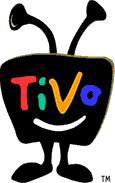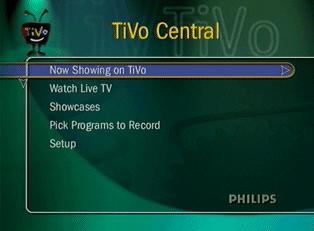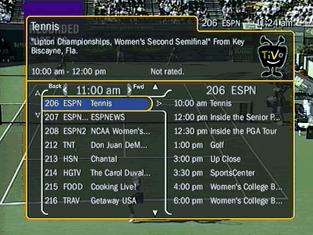
The ultimate in recording television programs, TiVo is a set-top box that does everything for you.

TiVo, Inc., headquartered in Sunnyvale, California, is the creator of the Personal TV Receiver. Michael Ramsay and James Barton founded TiVo in August of 1997. Ramsay and Barton were senior executives at Silicon Graphics, involved with early generation interactive video-on-demand systems.
The Philips Personal TV (PTV) Receiver is a joint effort between TiVo and Philips Electronics. Philips Electronics manufactures the PowerPC-based hardware, and TiVo designs and develops the software. The appliance uses a modified version of Linux for PowerPC and provides an amazing set of features. It truly is the next generation of VCRs, allowing you to watch what you want, when you want.
TiVo's PTV Receiver does have competition in this emerging market, such as Replay TV. However, the PTV Receiver is currently the only Linux-based system.
You can still do all the things you do with a VCR with the PTV Receiver—except play a VHS tape, of course. However, with DVDs becoming increasing popular, this may not be a significant limitation for you.
TiVo records digitally using MPEG II compression at one of four selectable video qualities. Picture quality at the best setting is as good as the original broadcast, an improvement over VCR technology. Although you can't exchange your recordings with others without copying them from TiVo to a VCR, you won't have to manage a handful of two-hour tapes, either.

Figure 1. TiVo Central
TiVo takes the concept of on-screen programming a step further. Rather than just recording what you schedule, TiVo allows you to rate, with either a thumbs up or down, programs you watch. TiVo will then record shows you've scheduled and shows it finds that match your preferences (see Figures 1 and 2.)
If you happen to watch Friends on Thursday night and give it a thumbs up, TiVo will also record syndicated reruns without being scheduled. What if the TV network switches your program to another night? TiVo will record it automatically at its new time slot, with no programming required. This is made possible by TiVo's built-in program listings, updated nightly by an automated toll-free phone call.
TiVo also enhances your TV watching. TiVo maintains 30 minutes of what's currently being watched, so you can pause, fast-forward or rewind live TV.
For example, if you're watching your favorite NFL team on Sunday, push the instant replay button on TiVo's remote and the action will skip back eight seconds and begin playing. Push the jump button, and you're back to live TV.
If you miss the start of a program, you can watch from the beginning while TiVo records the rest of the show.
Not sure what to watch? TiVo will provide you with recommendations based on your preferences. The interactive on-screen listing means you'll never have to pick up another printed TV guide.
A limitation of the current system is that it is unable to establish individual profiles for each viewer. Instead, TiVo creates a preferences profile for the household as a whole.
Having won a “Best of What's New” award for 1999 from Popular Science, the Personal TV Receiver is getting positive reviews from both audio/video and computer professionals. Ziff-Davis' Equip product reviewer summarized it like this: “TiVo rocks! I've been testing it for a few weeks and can't imagine living without it.”

Figure 2. TiVo Screen
Source code access, zero cost, high functionality, real-time capability and developer tools were among the factors that prompted TiVo to select Linux. The availability of a PowerPC port of Linux was crucial, since TiVo runs on a PowerPC-based system.
The current system is based on the 2.1.24 kernel. The GNU toolset and Tcl were used to develop all software.
TiVo had to modify the Linux kernel and some open-source tools in order to develop their product. In particular, they added an unbuffered scatter/gather API for disk access, real-time disk scheduling capability, an advanced DMA management subsystem, and support for demand paging and real-time processing. The unbuffered disk access allows the system to handle power outages gracefully. Users won't ever have to worry about waiting for fsck to repair the file system.
The TiVo receiver can update its software automatically. This includes both the TiVo application as well as the Linux kernel that drives the system.
During one of its nightly calls to get TV programming information, it will automatically download and install software updates. No user interaction is required.
A recent upgrade improved the picture quality during fast-forward and improved the algorithm for recommending programs. While certainly not new to PC software (America Online and others have been doing this for years), self-updating software is fairly new to consumer devices.
PowerPC-based Linux
Stores 14-30 hours
Inputs: cable-ready tuner, S-video and composite video support all U.S. standards
Outputs: RF, S-video and two composite video outputs
Channel Control: channel and power control of cable and satellite boxes with serial or IR
Dimensions: 17-1/8-inch width by 12-5/8-inch depth by 4-1/8-inch height
Compatible with all cable, satellite (DBS) and terrestrial broadcast TV systems in the U.S.
TiVo is available for $499 in the model that stores up to 14 hours on 13.5GB and $999 for the model that stores 30 hours on 27.2GB. You'll also need to sign up for TiVo's monthly service, which is $9.95 per month or $199 for a lifetime subscription. TiVo is available in a variety of retail stores including Best Buy, Circuit City and Sears. If you prefer to shop on-line, TiVo is available at 800.com, Amazon.com, CircuitCity.com and ROXY.com.